Farm Business Survey 2018-2019: profitability of Scottish farming
An analysis of Scottish Farm Business Survey 2018 to 2019 data, focussing on profit from farming in the supported sectors of agriculture, profit from alternative sources, support payments, and long term profitability of Scottish farm businesses.
This document is part of a collection
2. Profitability of Scottish Farming
2.1 Total Income from Farming (TIFF)
Total Income from Farming (TIFF) is the official measure of the profit (income minus costs) produced by all agriculture in Scotland and captures all elements of the industry.
Since 2005, the profitability of the sector had generally been increasing, but since the fall in 2015 growth has been slow, as shown in Figure 2.
If the figures are calculated without support from CAP and other payments (referenced here as subsidies), the farming industry as a whole has been in profit since 2010, though with little change in recent years. However, the level of profitability and the importance of CAP payments to farm incomes varies significantly across the industry,
This rest of this report focusses on the profit from farming in the supported sectors of agriculture and is based on data collected through the Farm Business Survey (FBS). This excludes non-supported sectors such as pigs, poultry, some fruit production and horticulture. However, it also allows for more granular analysis to be undertaken than is possible with the TIFF statistics.
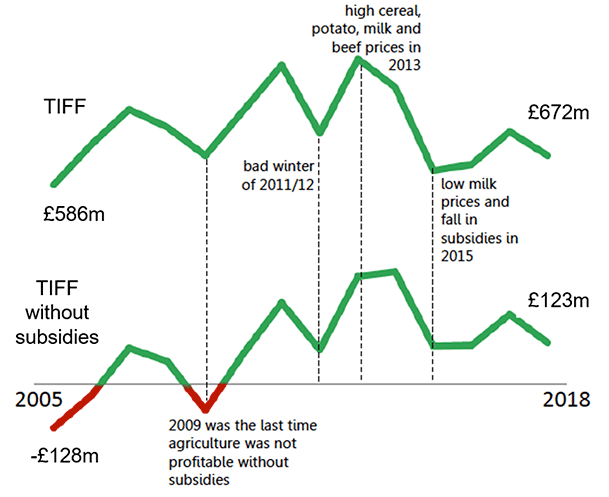
2.2 The Farm Business Survey (FBS)
The Scottish Farm Business Survey (FBS) allows an in-depth look at the profitability of the sectors in Scottish farming in receipt of CAP and other support payments.
Around 500 farming businesses take part in this voluntary survey each year. The FBS only includes farms with economic activity of at least €25,000 (equivalent to around £23,000 in September 2019). Part-time farms are not included[13]. The most recent figures from the FBS were published in March 2020 in the Farm Business Income: Annual Estimates 2018-19. More information about FBS methodology is available in Section 4: Data sources and more information.
The FBS is representative of around 11,000 farms in Scotland, which is around 22% of all farms included in the June Agricultural Census. These farms cover 64% of Scotland's agricultural land, employ 45% of those employed in Scottish farming, and produce 94% of standard output from the farming sectors that are included in the FBS[14].
The FBS collects information about inputs and outputs from agricultural activities as well as support payments received and inputs and outputs from diversified non-agricultural activities.
Diversified non-agricultural activities use farm resources to provide additional income, for example processing and retailing of produce, renting farm buildings, letting out holiday cottages or installing wind turbines and other renewables.
Support payments can include a variety of schemes with qualifiers including land use, land quality, livestock grazing density, environmental actions, forestry, community groups and improvements to the agri-food supply chain.
This analysis is primarily focussed on the profit a farm business makes from agricultural activities, and unless otherwise noted in this report, income from diversification is excluded from estimates of profit from farming.
Farms may also have some income from off-farm activities that are not part of crop or livestock production and do not use farm resources. The FBS collects information on off-farm income for farmers and their spouse but this is not included in estimates of farm business income and is excluded from this analysis of profitability from farming.
The FBS does not collect information on non-supported sectors, which include farms predominantly engaged in pigs, poultry, some fruit production and horticulture. A large number of part-time and small Scottish farms with low output are also not included. Unless otherwise indicated, these farms are therefore excluded from the analysis in this report.
2.3 Overall profitability and efficiency
There are different ways of calculating profit or profitability. In this report it is calculated as output less input and is equivalent to financial Net Profit. Estimates of profit can vary because different costs and prices may be selected[15].
Farm business survey data show that the average Scottish farm has relied on CAP support and other payments to remain profitable since 2012-13, as shown in Figure 3.
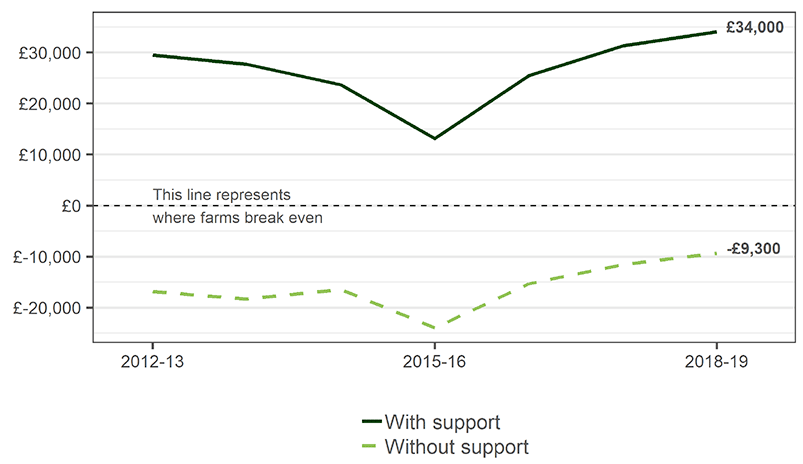
Since 2016 the average profitability with or without CAP support has been rising after the downturn in 2015-16 due to bad weather conditions.
In 2018-19, the average Farm Business Income (FBI) (or farm business profit) in Scotland was around £39,000. Of this, on average £34,000 came from farming and support payments, and £5,000 came from diversified, non-agricultural activities. When support payments and diversification are excluded the average farm made a loss of around £9,000.
The average farm received around £43,000 from CAP support and other payments. The majority of this support is through the CAP Basic Payment Scheme, which made up around 70% of the average farm support in 2018-19. A breakdown of the average contribution from support payments is shown in Figure 4.
On average, Scottish farms rely on support to stay profitable. However, there are large variations in profitability depending on farm type, agricultural systems and region.
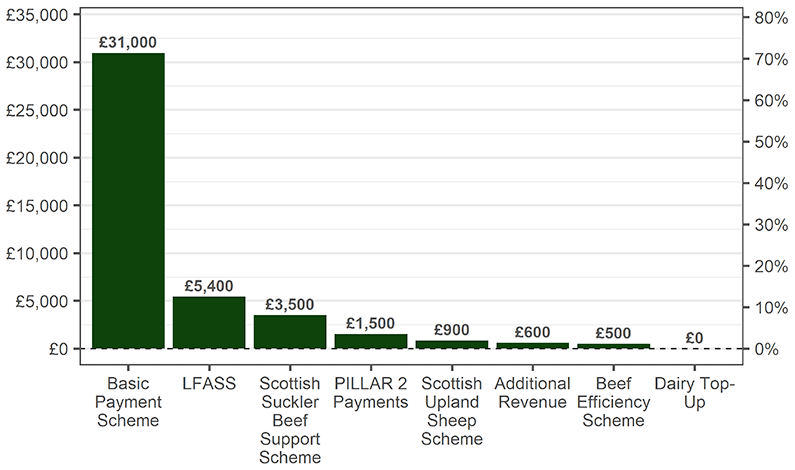
The profitability spread of Scottish farms in 2018-19 are shown in Table 1 and Figure 5.
The top 10% of farms made an average profit much higher than the average farm with or without support payments. Their profit was more than £150,000 higher. The lowest 10% of farms made over £70,000 less than the average farm.
| Lowest 10% | Average | Highest 10% | |
|---|---|---|---|
| Without support | -£110,000 | -£9,000 | £157,000 |
| With support | -£44,000 | £34,000 | £207,000 |
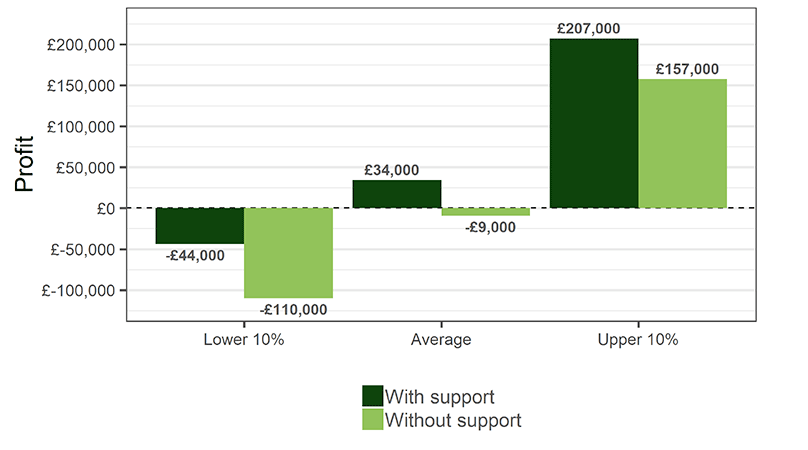
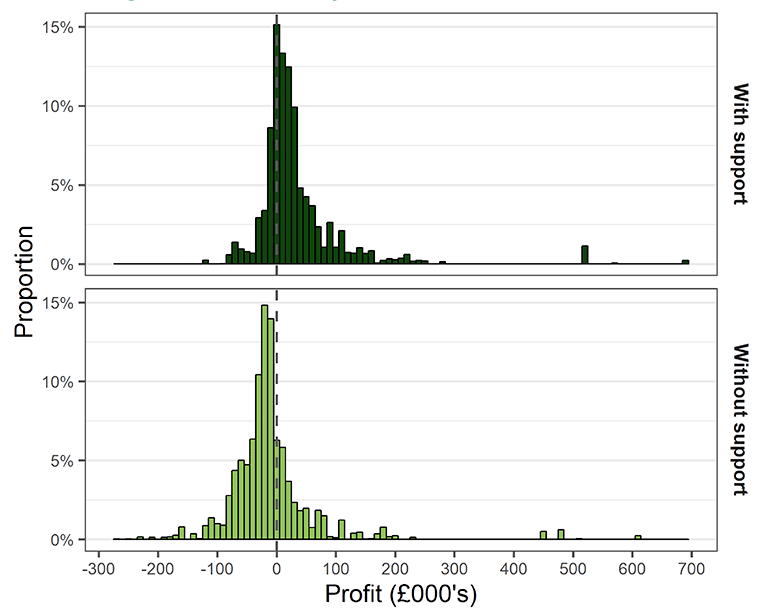
Figure 6 shows the spread of profitability across all farms. The inclusion of support payments means more farms turn a profit, shown in a shift of the profitability curve to the right.
However, a large number of farms still did not turn a profit after including support payments. In 2018-19:
- Without support, 28% of farms turn a profit
- With support, 72% of farms turn a profit
- Including support and diversification, 76% of farms turn a profit
To investigate profitability without support payments in more detail, the data has been split into deciles. 10% of the farms represented by the FBS are included in each decile.
Only the top three profitability without support deciles had an average profit above zero (deciles 8, 9 and 10) in 2018-19, as shown in Figure 7.
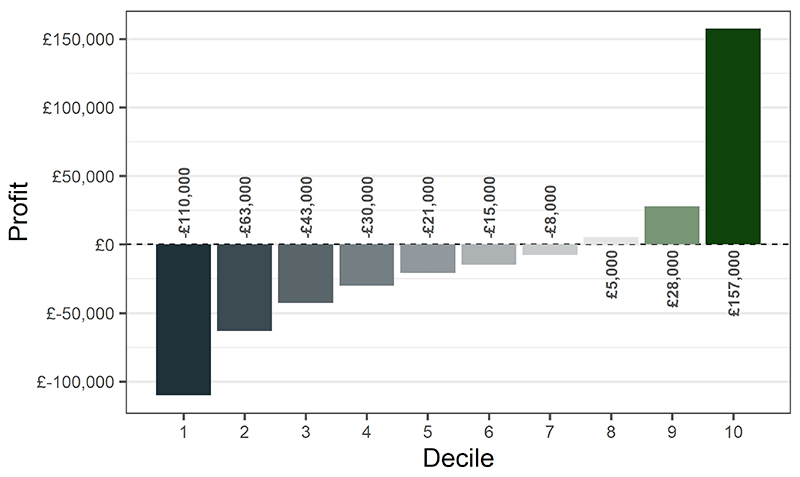
Analysis of support payments data shown in Figure 8 shows that farms in the lowest performing deciles receive the highest average payments, while the top performing six deciles receive a lower level of payment.
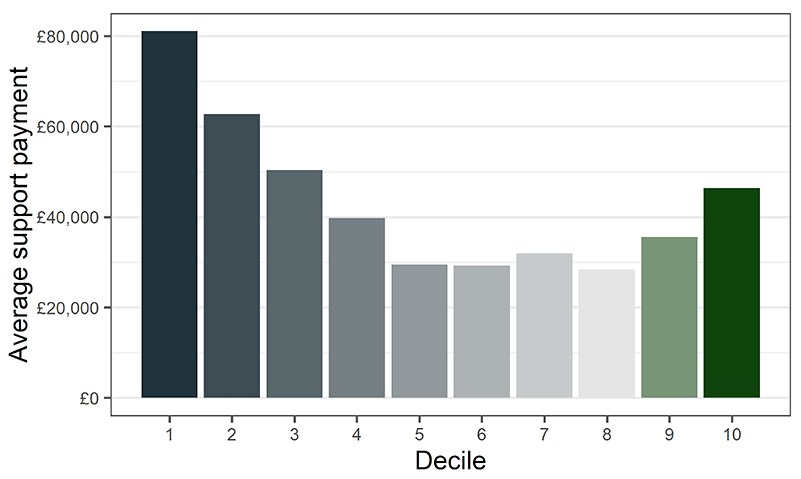
An alternative way to assess a farm business is efficiency, estimated by calculating the output for every £100 spent on inputs, excluding support payments. The breakeven point is where a farm business spends £100 on inputs for every £100 of output they produce.
Although there are multiple factors in farm profitability over time, the efficiency estimates shown in Figure 9 suggest that if support payments were removed, a farm in decile 1 would need to increase outputs by around £80 for every £100 of inputs, or around 80% to break-even. As above, only the three deciles of highest performing farms without support reach above the breakeven point when analysed by efficiency.
Other aspects of farm business impact the overall profitability from farming, and are discussed in more detail in Section 3.
Profit from farming may not be the only contributor to total farm business income, with diversified business activity becoming an integral part of many farm businesses. In 2018-19 an estimated 46% of farms increased their income through diversification.
Assets and liabilities also impact farm businesses. On average, farms had assets worth £1.5 million, and liabilities of around £180,000 in 2018-19.
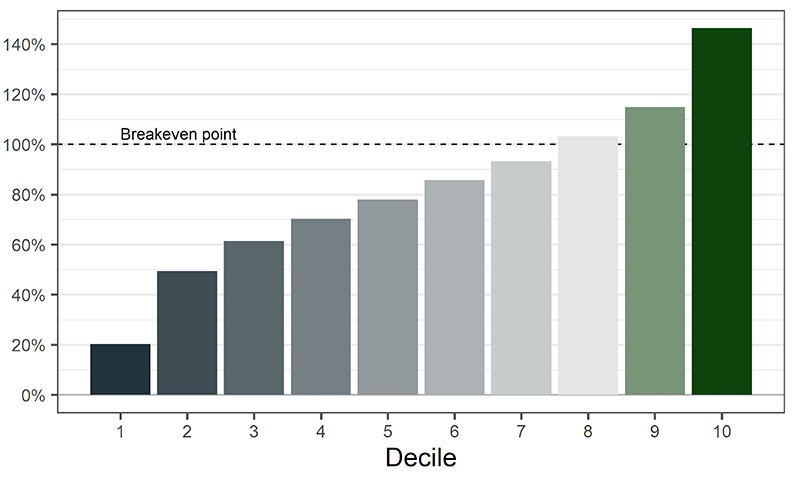
2.4 Farm type
Table 2 provides an overview of profitability and support payments by farm type.
Sheep farms and cattle farms in less favoured areas generally have the lowest profitability and have been historically low compared to other farm types. These farms are mostly found in remote areas with significant challenges to overcome in both the natural landscape and other factors such as distance to populated areas and markets. Current support schemes provided through Greening or other Pillar 2 payments allow many of these farms to make a profit and to remain an active part of the community, as shown in Figure 10.
| Farm type | |
|---|---|
| High profitability | General cropping and dairy |
| Low profitability | Livestock and LFA |
| Low support | Dairy, general cropping and cereal |
| High support | LFA livestock |
Dairy farms and general cropping farms often have higher incomes and are the most profitable sectors of agriculture supported by CAP payments. The performance in these sectors can be adversely affected year to year either through sensitivity to market prices or extreme weather events.
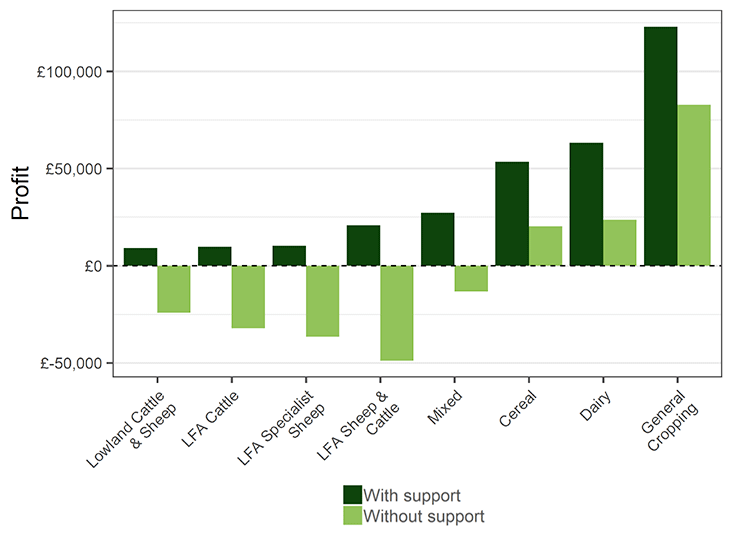
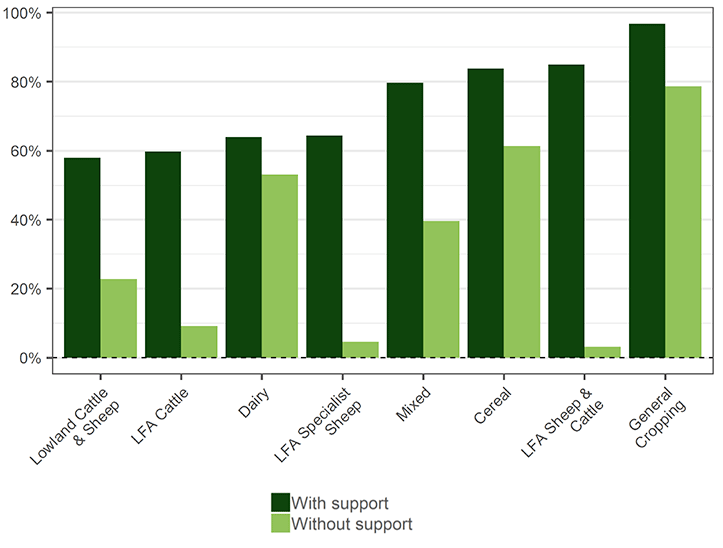
As shown in Figure 11, with support payments included there is relatively little variation in the proportion of profitable farms between farm types. Between 50% and 100% of farm businesses were profitable with support payments. Without support, the proportion of profitable farms is very variable by farm type. Less than 25% of farms were profitable in any predominantly livestock or LFA farm type without support payments.
LFA livestock farms have very few farms profitable without support payments (less than 10%) mainly due to the additional constraints of land type and rurality. These types of farming rely on support payments.
Figure 12 shows the proportion of farms in each farm type by their profitability decile and shows how profitability is distributed across farms in each farm type.
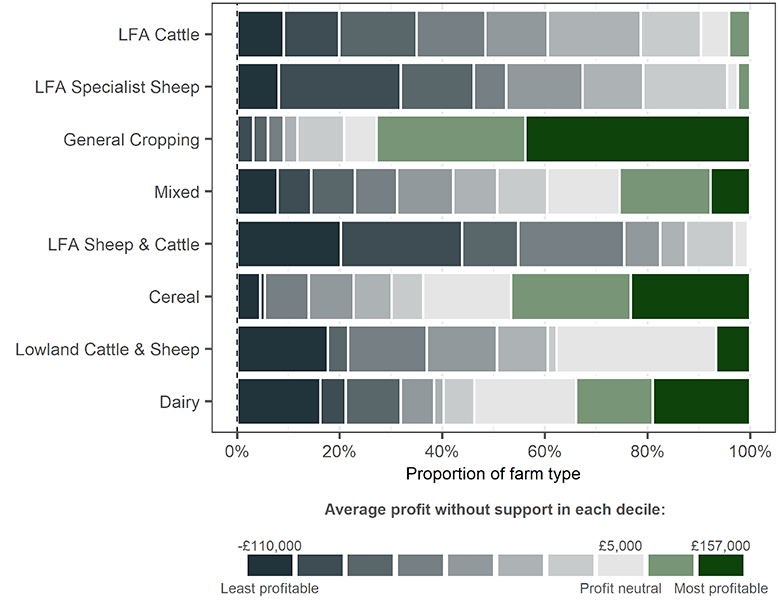
LFA and livestock farms have a high proportion of farms in the lower profitability deciles, though a small proportion of Lowland Cattle & Sheep appear in the highest profitability decile.
Dairy farms, general cropping farms and cereal farms have higher proportions of profitable farms, however, Figure 12 shows that while some farms in these categories may make large incomes, some will also be making a loss.
Almost every farm type has at least a small percentage in the lowest profitability decile, suggesting there is scope to improve profitability across sectors.
2.5 Region
Table 3 provides an overview of profitability and support by region from the farm business survey data. This reflects the pattern of regional results for profit from the agriculture sector as a whole, as described in Section 1.1.
| Region | |
|---|---|
| High profitability | Eastern and Northern Scotland |
| Low profitability | West Central Scotland, Southern Scotland, Highlands and Islands |
| Low support | Fairly consistent across regions |
| High support |
As shown in Figure 14, profitability and the proportion of profitable farms is highly variable across the regions of Scotland with and without support payments. This reflects the variations in land use and LFA land in each region, as shown in Figure 1.
Eastern Scotland was the only area with average profitability above zero without support in 2018-19.
Without support payments, less than 50% of farms are profitable in all regions, with the highest proportion in Eastern Scotland. With support payments, more than 75% of farms in Eastern and North Eastern Scotland are profitable.
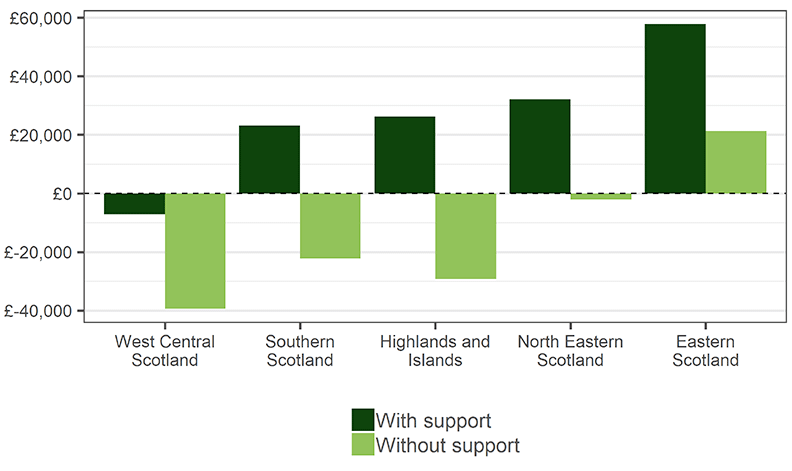
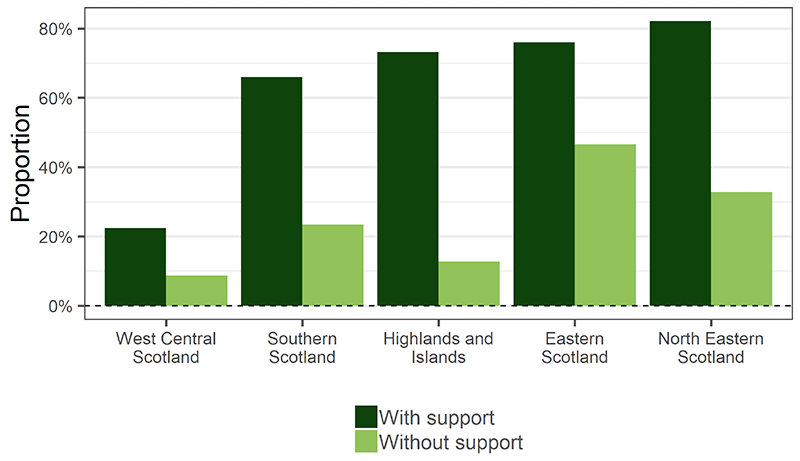
Most regions show a spread of profitability deciles, as shown in Figure 15. Eastern and North Eastern Scotland have the largest proportions of high profitability farms.
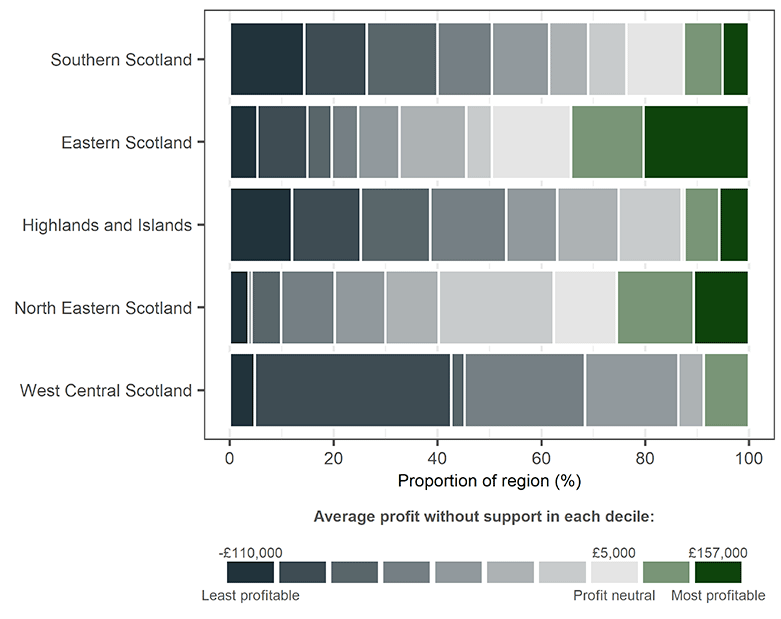
2.6 Tenure
Table 4 and Figure 16 provide an overview of profitability and support by type of farm tenure. On average farms with mixed tenure have the highest profitability both before and after support payments. Mixed tenure includes farms under a partnership agreement between the landlord and tenant where both contribute to the financing and benefit from the farm profit, as well as farms with other tenure arrangements not classified as owner-occupied or tenanted.
| Tenure | |
|---|---|
| High profitability | Mixed tenure |
| Low profitability | Owner-occupied |
| Low support | Owner-occupied, tenanted |
| High support | Mixed tenure |
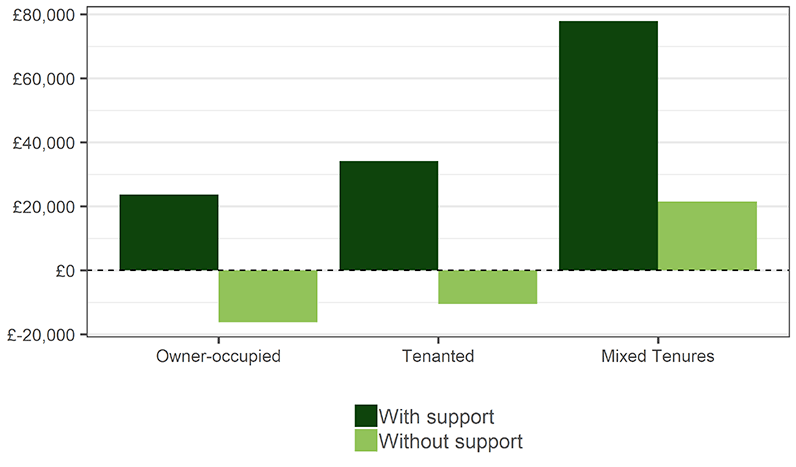
There is little variation in the proportion of farms that are profitable by tenure, or across profitability deciles by tenure, as shown in A1 and A2 in Annex A: Additional figures.
Contact
Email: Harriet.Houlsby@gov.scot
There is a problem
Thanks for your feedback